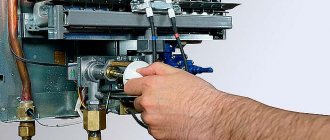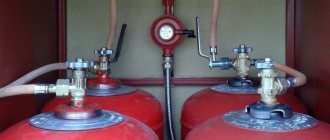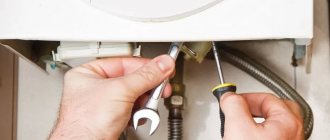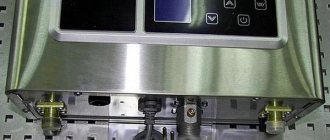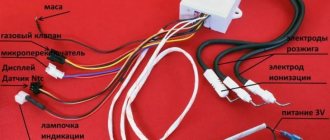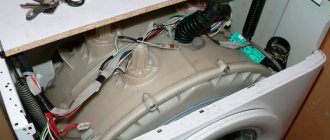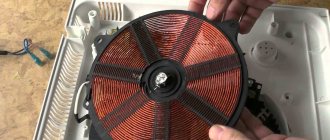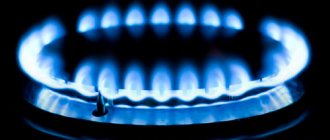You've been using your water heater without any problems, and then it starts making strange noises. This alarmed you and aroused suspicion. Why is the boiler humming, what are the reasons for the extraneous sounds? It is important to find out what is wrong, as the equipment may give you signals that there is a serious breakdown. And if you do not figure out the reason, then soon the device may completely fail.
Nature of faults
It is important to remember that the appearance of any extraneous sounds from the speaker body is always a consequence of three main reasons:
- Incorrect or untimely maintenance;
- Manufacturing defects;
- A very long service life, after which the manufacturer cannot guarantee the safe operation of the column.
In the first two cases, specialist intervention may be required, even if the issue does not concern the gas part of the equipment. Manufacturers themselves strongly recommend contacting specialized gas services if the boiler no longer meets the stated requirements, or if other factors causing concern have appeared in its operation.
In the latter case, it is recommended to immediately replace the outdated equipment with new one in order to prevent the situation from worsening, where at best the device will stop working normally, and at worst it can lead to gas contamination and an explosion. What this may be connected with and what other signs may indicate a malfunction of the gas water heater, we will consider further.
Questions about speaker malfunctions
Column NEVA LUX-5514 after changing the membrane in the water-gas unit, the tap regulating the gas supply to the burner stopped working. How to fix?
The gas outlet channels on the heat exchanger are clogged. Remove it and wash the top with a strong stream of water - everything will work.
In the Neva 3208 column, the igniter burns well, but inside it barely smolders, although the handle is turned to full power. What is the reason?
Membrane problem. It needs to be replaced.
Beretta speaker, I've been using it for 8 years. The igniter lights up only after 30 clicks on the piezo ignition, or it lights up and goes out immediately! What can be done?
A malfunction indicates a blockage or failure of the ignition group. Perhaps cleaning it will help. But most likely it will need replacement.
To eliminate problems in the operation of a gas water heater, you need at least basic knowledge about its structure and repair skills. If your speaker is under warranty, don’t hesitate to contact a specialist. They will eliminate the cause of the malfunction free of charge and repair or replace the necessary parts of the device. You cannot open the column yourself before the warranty period expires.
The appliance is noisy when heating water
Modern boilers operate quietly, so vibration, noise, and extraneous sounds should alert you. What could be an indirect reason:
- Incorrect installation, connection.
- Incorrect setting.
- Wear of components.
There are also very specific reasons why the boiler is humming.
High oxygen content
The water in the pipes is oversaturated with oxygen, which causes bubbles to form when heated. This effect leads to increased noise and vibration not only of the device, but also of the batteries.
Air accumulation in the system
If the boiler knocks and puffs, it is necessary to bleed the air in the pipes. Modern radiators have taps installed. By unscrewing them, you can remove the accumulated air.
Scale formation
A high content of salts in water leads to their deposition on the walls of the heat exchanger. Therefore, when heated, the unit will hiss. In addition, the heating rate and heat transfer are reduced. It is recommended to clean the radiator once a year. To do this, a pump with a reagent is prepared, and the cleaning liquid is pumped through the hoses.
Fan problems
The fan operates in models with a closed chamber and forced removal of combustion products. Why does it make strange sounds when rotating, whistling:
The grease in the bearings has dried out due to placement above the burner. When exposed to high temperatures, the lubricant dries quickly, which leads to bearing wear. The part is disassembled and lubricated.
Unbalanced blades, accumulation of dirt and dust. The blades are cleaned and rotated.
Excessive pressure in the heating pump
The pump produces high pressure; its settings need to be adjusted. Too high pressure in the system can lead to an emergency. The values can be adjusted by switching the white lever on the terminal box.
A lack of water in the system leads to serious overheating. First of all, check the thermostat settings, set them to lower values. Measure the pressure and add coolant if necessary.
And:
- If the boiler howls, it is due to an incorrect setting of the gas valve or bypass (jumper pipe).
- When operating at high power, the gas meter may rattle.
- A worn valve makes rattling sounds.
The boiler (titanium, water heater) makes a sound. Howls, squeaks, crackles, whistles, buzzes
Over time, any boiler (water heater) will sooner or later begin to make extraneous unpleasant sounds.
On the Internet, people talk about many reasons that are responsible for the generation of different sounds, but I could not see the correct actions to eliminate these problems anywhere.
I can offer you my version of searching and eliminating these problems associated with the sound of the boiler.
The main reasons for the appearance of a squeak, buzz or whistle in the boiler can be identified in three ways:
A large layer of scale or limestone deposits appeared on the heating elements
The bypass valve and the plumbing associated with it are acting up
Very poor water quality in your home
Now about everything in more detail...
Scale on the heating element of the boiler (heating element) may be the least likely problem in the appearance of whistles.
But, if the scale does not exceed a thickness of 1 cm on the element, otherwise, this will also be a source of whistles, crackles and other sounds in the boiler.
In some settlements and cities, local water treatment services do not properly degas water, probably on purpose, since this increases water consumption according to meters, with smaller volumes of water consumption.
In human terms: as a rule, there is always a certain percentage of air in water; in some certain areas of our country this percentage is more or less than the average value. According to utility standards, services must remove excess air in water to a certain standard value. This same air can subsequently create the effect of a characteristic sound when the water begins to heat up. A friend of mine in the city has this exact reason why the boiler beeps. I live in Vladivostok, it seems that we don’t have such an effect from water.
An even more common cause of boiler sounds is a problem bypass valve.
When purchasing a boiler with the tank itself, there is an accompanying combined device, which is designed to relieve excess (excessive) pressure in the tank and a check valve designed to prevent the outflow of water in the opposite direction. Over time, if the pressure in the boiler tank is constantly high, with frequent discharge of excess water, this valve begins to undermine. And it is recommended to replace it. Fortunately, it’s not difficult, any man with his hands can do it.
This valve is also responsible for equalizing pressure not only in the water heater, but also in pipes located below and above itself. For example, neighbors or you open a cold water tap, the pressure in the water supply drops and a certain amount of water passes through this valve with a sound from the water heater into the water supply.
In rare cases, the relief valve may make sounds when there is increased pressure in the cold water riser. The way to eliminate the problem is to install a pressure reducer on the apartment's water supply system.
The speaker whistles
If a monotonous loud whistle is coming from your equipment, you should first determine where it is coming from. To do this, turn off the gas tap, and then open the hot water tap. Further actions depend on the resumption or absence of “trills”:
- If a whistle appears, its occurrence is associated with the water path. The most common reason for this sound is scale deposits in the heat exchanger or a foreign object getting inside the pipe. At the same time, the performance of the column decreases. In this case, to get rid of the whistling, you need to clean the heat exchanger from scale, and the reverse flow will help wash out the foreign object from the column.
- If there is no whistling sound, the cause of its occurrence was problems in the gas path. Most often they are associated with a defect in the valve that modulates the flame power. Then the whistle appears only at a certain power, and to eliminate it, you need to adjust the power in any direction. Another common cause is a clogged tract. Whistling sounds appear at any power. To identify the location of contamination, you will have to carry out extraordinary cleaning, which is best entrusted to a specialist who works with gas equipment.
After watching the following video, you will be able to clean the heat exchanger from scale yourself, without contacting a professional.
The presence of a gas water heater in a house or apartment solves the issue of hot water supply. It is easy to use and, as a rule, does not cause problems for users. Therefore, the situation when a water heating device clicks, whistles, or crackles is, to put it mildly, unpleasant, don’t you agree? But what to do in this case?
In this article we will look at the main reasons why a gas water heater hums and also makes other extraneous sounds. Let's talk about when it is necessary to immediately call a specialist, and in what cases you can restore the operation of the device yourself.
Features of the geyser device
To understand whether extraneous sounds are related to problems with the speaker, it’s worth taking a closer look at its structure. Different models have characteristic features, but the principle of operation of any device of this type is identical.
The basis of the geyser is a box, usually rectangular in shape. Inside there are tubes supplying water and gas. Cold water enters the column and passes through the radiator compartment. In it, water is heated under the influence of a flame coming from a burner.
As soon as the tap opens, from which heated water should flow, the valve inside the column is activated and the gas supply is turned on. It enters the combustion chamber, in which the water is heated.
Exhaust gases exit through the chimney (ventilation) duct. Depending on the modification of the device, this occurs on the basis of natural or forced draft.
Natural draft speakers require a chimney of a certain diameter. If it is impossible to install it, install turbocharged speakers. They are additionally equipped with fans to remove exhaust gases through a coaxial pipe. The combustion chamber in such devices is closed.
If one of the nodes operates incorrectly, the protection is triggered and the column is turned off.
This may happen in the following cases:
- there is insufficient draft in the chimney;
- the burner has low heat;
- insufficient water pressure;
- heat exchanger overheating.
Sometimes the speaker continues to work, but at the same time makes various sounds, which also indicate a problem.
Popping sound when turned on
If you hear a pop when you turn it on, this indicates a problem with the gas supply. Each device has a working area in which fuel accumulates when the equipment is turned on, as well as its connection to air. If the volume of accumulated gas coincides with the manufacturer’s calculations, then there will be no extraneous pops. And if gas and air accumulate in excess, this leads to a small explosion accompanied by a loud bang. This action not only produces an unpleasant loud sound, but also increases the risk of damaging the chimney. You can solve the problem by calling a technician to your home or by yourself if you understand the design of the device. You can fix a geyser with your own hands like this:
- turn off water and gas;
- remove the body;
- inspect the gas pipeline approaching the burner;
- if necessary, clean parts from soot and soot;
- inspect the condition of the injectors; if there is contamination, clean the elements.
How to get rid of sound?
You can get rid of extraneous hum in your speakers yourself. Let's consider what to do for this.
Computer settings
Incorrect settings used when configuring Windows OS (a common operating system installed on most computers) often cause humming noise in the speakers.
To fix problems, you need to perform a number of steps.
- Open Control Panel. You can find the required item in the Start menu.
- Click on the "Hardware and Sound" section. There will be a subsection called "Sounds".
- Select the audio playback device marked with a green checkmark.
- Right-click on it and then click on the “Properties” line.
- The “Levels” tab will appear in the window that opens.
- In the Realtek settings, under the first line, additional sources will be displayed that need to be reduced to the minimum level.
- Next you need to open the tab called “Improvements”. Opposite the Loudness parameter there should be a checkmark confirming that it is enabled. This option may be called differently in different versions of the operating system, such as “Volume Leveling.”
- After making new settings, you should check the sound.
Driver problem
Software is an important component of equipment operation. In some cases, the problem can be completely corrected by a simple software update. Some operating systems independently notify the user that the driver needs to be updated and perform this procedure automatically.
Otherwise, you can find the program you need on the Internet. They are in the public domain.
Afterwards you need to make the necessary settings.
- The procedure begins by opening the “Control Panel”.
- The next item is “Equipment and Sound”.
- Find the subsection that is responsible for the sound driver settings. In most cases it is called "Realtek HD Manager".
- Open this item and carefully evaluate the menu. When changing parameters, evaluate the result. You can turn some audio filters on or off, and change the volume.
Turned off the water, but there is a whistle
If the gas water heater whistles after turning off the water, then this is a sign of a breakdown of the water controller.
A rod with legs is located inside the block. It is connected to the ignition mechanism. After turning off the water supply, a special spring should perform its function - it returns the working rod to its original position. If there is rust on the rod, it will jam. The ignition system does not turn off and generates a spark.
This is the answer why the device whistles even if you turn off the water. The solution is to replace the damaged water controller membrane.
Basic steps
What to do if the gas water heater whistles? The first step is to calculate the source of the sound. Turn off the gas. Open the mixer in the hot water position. If the problem is not serious, the gas unit immediately stops whistling.
If the whistling gets worse, pay special attention to the water path. Study its components: pipes and maintenance, and its components. They could get clogged. A particularly common situation is the accumulation of scale on them.
And scale often accumulates if the set water temperature parameters constantly exceed 60 degrees.
Back pressure should only be applied after turning off the gas and water. You also need to unscrew the liner at the inlet section.
The easiest way to carry out this operation is to use a faucet in the bathroom. The shower switch must be set to the neutral position. The taps should be opened slightly.
To remove lime deposits, use a descaling agent. You can also work with folk remedies: acetic or citric acid. They are diluted in the correct proportions. The resulting composition is poured slowly into the water path. It is added according to the degree of sound attenuation. Then repeat this procedure three more times.
And when you open the tap and there is no whistle, the problem could be hidden in the gas path. This means that there is possible damage to the valve for adjusting the flame power.
This is the most common answer why the unit does not stop whistling. The problem is especially pronounced when achieving the optimal ratio of gas flow dynamics and valve clearance width. This ratio may have different values in different columns.
If the gas water heater whistles when operating in high power mode, you need to adjust the regulator until the annoying sound disappears completely. Turn it smoothly, now in one direction, then in the other. The dynamics of the gas flow will decrease. It is not enough to produce sound. If it is increased, the valve clearance will expand, and the unit may start whistling again.
If these measures do not give the desired effect, it means that the gas path is clogged. The device will whistle even louder. It urgently needs to be disassembled, the problem area identified and thoroughly cleaned.
If your geyser is still under warranty, contact service immediately. You will have to contact them if the warranty period has expired and you cannot solve the problem on your own.
Solving the dilemma on your own is possible when you have the necessary knowledge and skills. The task comes down to cleaning this tract. Scale or winding elements could be stuck in it. If this is the case, the speaker will begin to whistle very powerfully.
Other causes of noise
Sometimes the cause of noise in a working geyser is not a breakdown, but loose communication connections or a poorly secured element. Therefore, if extraneous sounds appear, it is worth checking the tightness of the parts and pipeline connections. You can also see if anything has gotten into the device body. Perhaps after the last disassembly they forgot a bolt, electrical tape or other item.
When noise appears in a gas water heater, it is important to determine the cause and solve it as quickly as possible. A hum is the first sign of a problem with the device. If the problem is not corrected in time, it will gradually lead to more serious consequences. As a result, you will have to buy a new gas water heater instead of small repair costs.
The freezer is noisy: is it a malfunction or normal?
Note that there is currently a trend towards reducing noise levels in household devices. Manufacturers are coming up with new technological solutions. Meanwhile, today there are no completely silent models. The noise level is indicated in decibels in the operating instructions.
If the equipment is noisy, but no additional signs are observed: water does not flow out, there is no burning smell, the display shows the operating temperature, no alarm signals or error codes are received, most likely, there is no need to worry!
All sounds are natural. Thus, crackling sounds are produced by elements of the cooling circuit.
Motor-compressors for refrigeration and freezer compartments
When the motor-compressor is turned on, the freezer starts and the thermostat clicks. A similar thing happens when you turn it off: a click and the motor stops humming.
The gas boiler hums and whistles
A gas boiler can make noise throughout the entire apartment, thereby interfering with sleep. Is it possible to get rid of this noise? In fact, the cause of the noise lies in the chimney. In this case, the chimney needs to be enlarged and expanded. The narrower it is, the stronger the rumble.
Operating principle of combined heating boilers
Often the gas boiler begins to hum loudly. The reason is the stabilization system, which regulates the level of gas pressure that enters the combustion compartment. To prevent sounds from interfering with a comfortable existence, it is better to locate the boiler room away from the living space. If it has already been built next to your home, you can solve the issue by ensuring soundproofing of the room. There are a great variety of materials for this.
If the boiler starts to boil like an electric kettle, it means the primary heat exchanger is clogged. Finding out whether there is a blockage is quite simple. You need to set the boiler to the maximum temperature and turn on the supply valve so that there is a small flow of water. At around 80 degrees the hum increases. There is only one way out - clean the heat exchanger.
Release mechanism with float
Valves of this type are divided by type and method of action:
Push. These devices are divided, in turn, into categories:
The exhaust valve is single-mode. Such a device is equipped with one key, when pressed, all the liquid is drained from the tank.
Valve with "off" mode. In this mechanism, the initial impact leads to a small flow of liquid into the toilet, and the second one ends the water supply.
The exhaust valve is dual-mode. This device has two buttons on the lid of the tank, and when you press the first button, a certain portion of water comes out, and after pressing the second button, the container is completely emptied.
- Exhaust. With this device, the valve that closes the drain hole is raised by raising the rod.
- Lever. The exhaust system is activated by acting on a lever, which can be located either below or near the toilet.
Regardless of the method of influence and type of device, the operating principle of the components of the release mechanism is the same. It should be taken into account that the shut-off valve is connected to the float via a copper rod or plastic rocker arm.
As soon as the water is drained after use, the float lowers, and at the same time the draft moves the shut-off valve. Through the resulting hole, water quickly begins to flow into the tank. When the float rises completely, the valve, under the influence of traction, closes the hole, as a result of which the water supply to the drain tank stops.
Difficulty starting hot water
The device can seriously whistle when you turn on hot water. When turned on in this way, the speaker may make noise with a gradual development of noise. Or he might immediately whistle very loudly and obnoxiously.
Why does the gas water heater whistle when you turn on the hot water? How to eliminate this complexity?
The gas is shut off. The hot water tap opens. The equipment should no longer whistle if this is a mild case. If the noise continues, inspect the plumbing. Potential causes also include:
- Blockages in the maintenance or water regulator.
- Rust on important components.
- Scale on the coil.
There may be a whistle in the column even after turning off the gas. Why is this happening? The answer is that some component of the gas control valve has broken down.
If the model is automatic, then in such a situation the whistle indicates scale in the maintenance system and a breakdown of the gas valve. The pipes should be cleaned.
Whistling
Strong or minor whistling can be heard from different places in the equipment. The cause is a pipe connection failure. First of all, it is necessary to accurately determine the location from which the whistle is coming.
The procedure is as follows:
- Close the gas pipe and open the hot water. If the whistling noise continues, inspect the water supply system. When using the column for a long time, limescale (scale) forms inside the pipe. Most often, this is the reason for the whistling. The diameter of the pipe decreases and water passes through with difficulty. To fix the problem, wash the heat exchanger with a special solution, folk remedies (citric acid, vinegar and soda) or replace the part.
The cause of whistling can often be scale
- If the whistle stops after opening the tap, this indicates that the problem is in the gas supply pipe. The flame control valve is probably broken. Reduce burning intensity. Turn the adjuster one way or the other. If the whistle decreases, the device needs to be cleaned.
- If adjusting the valve does not produce results, cleaning the gas pipe is necessary.
Scale formation in the heat exchanger is a common problem that impairs the performance of the column. To prevent this, you need to install a filter at the cold water inlet that reduces hardness.
Responsibility for unauthorized replacement
It should be remembered that replacing a boiler, water heater and other gas appliances in an apartment in a multi-storey building or in the private sector should only be carried out by qualified employees who have official permission to perform work with gas and gas equipment. You can also contact specialists from the state gas service. Self-repair or connection of equipment is not prohibited by law, but it is necessary to understand the full responsibility of such actions.
If you independently interfere with the gas supply system and tap into it without permission from the gas service, you will bear full responsibility in accordance with Federal Law No. 229-FZ, adopted in 2022, “On amendments to Article 215.3 of the Criminal Code of the Russian Federation and Articles 150 and 151 of the Code of Criminal Procedure of the Russian Federation” .
There is a fine for such violations of up to 80 thousand rubles. Also, the violator may be punished by performing correctional labor for up to 360 hours. The offender can also be sent to correctional labor for up to one year.
In addition, they may be sentenced to restriction of freedom or complete deprivation of freedom for 2 years. In the event that after an independent intervention in the gas system, an accident occurs, as a result of which people were injured. Then the violator will be punished with the same fine, correctional labor for up to five years, and even imprisonment for up to 8 years.
To replace gas equipment, you must have a special permit. If an accident occurs and people are injured, the culprit will suffer administrative punishment upon initial prosecution, in accordance with Article 7.19 of the Code of Administrative Offenses of the Russian Federation in the form of a fine.
If a violation is detected again by the same person, the violator will be prosecuted in accordance with the adopted Federal Law No. 229-FZ “On Amendments to Article 215.3 of the Criminal Code of the Russian Federation (CC RF) and Articles 150 and 151 of the Criminal Procedure Code of the Russian Federation (CCP RF)".
Options to prevent problems
The first way is to visit your neighbors
Any malfunction of your gas pipeline requires mandatory inspection by gas company specialists. A characteristic hum inside your gas pipeline indicates a serious problem. In any case, before calling professionals, you must make sure that there really is a problem, since uncharacteristic noises over a certain period of time can come from the residents living next to you. It is likely that the noise is coming from your neighbors' pipes. As a rule, it often happens that your neighbors have moved their refrigerator or purchased a hood next to a gas pipe, that they are in close contact with the gas pipeline, which contributes to the appearance of such noise and vibrations.
Installing any equipment close to a gas pipe contributes to frequent vibrations throughout the gas pipeline of the house, in particular among neighbors living nearby. To make sure of this, visit them and explain to them the reason for your visit. If the reason is confirmed why your gas pipe is humming in the kitchen, you need to solve the problem with the residents, asking them to move the refrigeration or ventilation equipment to another place.
The second method is to clean the gas stove burner
Unusual noise may occur as a result of contamination of the injectors during maintenance. In addition to the hum itself, the pressure flow of the gas flow flowing to all nozzles decreases. If the gas is supplied with great difficulty and the flame burns low enough, this indicates that the burners are dirty. You will need to clean them yourself by performing a number of simple steps:
- to clean the contaminated surface, you will need to carefully remove the burner lid from the stove, and, if necessary, carry out the cleaning procedure from all edges;
- To clean the nozzle - a small hole in the center of the burner, take a paper clip, straighten it, insert it into the hole and scroll 1-2 times until there are no problems with the passage of the channel.
- Put the burner in place and check it for the quality of the gas flow. Moreover, be careful when trying to pass gas directly through the nozzle. In this case, it is forbidden to clean it with water or vinegar solution, since no liquid should enter the nozzle.
If you managed to clear the dirt on your own, when cleaning the injector nozzles, gas will flow as usual, and along with this problem, the intense noise will disappear.
The third way is to call a specialist from a gas organization
If, after carrying out all the steps, a thin paper clip or wire encounters any obstacle in the nozzle, then call gas service specialists. Since the presence of an unpleasant odor in the apartment may indicate a malfunction of the gas pipeline, which can lead to consequences for all residents of the apartment building. When called, an employee will inspect all injectors and, if necessary, replace the necessary part. As already reported, before calling the gas organization, fulfill three conditions:
- check with your neighbors to make sure they are not involved in the noise;
- check the fastening of the clamps of your gas pipeline;
- Observe all burners and, if necessary, clean them and the nozzles with wire or a paper clip.
The speaker hums and makes noise during operation
The cause of noise when heating water is insufficient draft. Therefore, in noisy equipment, it is the first thing to check. A lit match or lighter is brought to the control holes or a special hatch in the upper part of the column. If the flame deviates towards the device, the draft is sufficient. Otherwise, care should be taken to clean the chimney duct.
Also, noise can be caused by insufficient air flow into the room, for example, if plastic windows are installed in the kitchen. The seals in such windows interfere with the natural ventilation of the room. In this case, to eliminate noise, you should simply control the air flow.
Another reason the column is too noisy is that the pilot burner wick is dirty. And then to eliminate the noise, it is enough to clean the jets. A similar situation is possible if the jets in the main burner are clogged, then after cleaning it, the hum during operation of the column disappears.
In modern speakers that are turned on using electric ignition, the cause of noise during operation may be as follows:
- Discharged batteries. As a result, the gas-air mixture is difficult to ignite. In such a situation, the batteries need to be replaced.
- Damage to the sensor that controls the water supply. Often its malfunction is caused by oxidation of the contact group. Usually this sensor is not removable, so it is replaced.
- A spark plug malfunction prevents an electric spark from being produced. Most often, it shifts after many heating-cooling cycles. By returning the spark plug to its nominal position, you will restore the possibility of spark formation and eliminate extraneous noise.
- Problem with mechanical ignition retarder. Its presence can be determined after dismantling the assembly and shaking it - normally you should hear the noise of the ball moving inside the moderator. If there is no sound, this indicates that the ball is moving. You can return it to its place using a soft wire.
Column with automatic ignition system
In modern models, ignition is carried out automatically. Thanks to this, the owner manages to save 10 m3 of gas. But improved operating parameters make the equipment more complex and reduce its reliability. In it, ignition is controlled by an electronic control module connected to microswitches.
Failures rarely occur in the operation of such a system, but there is a certain risk. In this case, you will have to find out why there is a bang when you turn on the gas water heater. Repairs can cost a large amount. This is the main disadvantage of such devices.
If the Neva gas water heater clicks, then you must perform the following steps:
Check the charge of the batteries powering the module. An electronic ignition system is found in equipment such as the Neva, Oasis and others. If the battery is discharged, it will not work when igniting. Then you can hear something hissing or crackling. To cope with the problem, just change new batteries. Assess how correctly the fluid pressure microregulator works. The manufacturer installed this element in the column so that it sends signals to the control module. It is activated when the water supply starts and there is a need to ignite the gas. If there is a problem with the micropressure regulator, then when water gets in, the commands will be issued incorrectly. Because of this, geysers make noise. To detect problems, you must use a multimeter or ohmmeter. It should be used to measure indicators. If they do not meet the requirements, the system has failed, which is why the gas water heater slams. You can correct the situation by replacing the old part with a new one. Find out whether the gas ignition device is located correctly or not. If there is a popping sound when you turn on the gas water heater, the reason may be this element. It can change its shape under the influence of sudden temperature changes, because of this the dimensions of individual parts of the structure change. This part is held on by one screw, so it is not difficult to fix. To do this, loosen the screw and align the spark plug. It is this element that ensures the creation of an electric spark. Modern spark plugs rarely break, as they are designed for long-term use. If the ignition device has changed its nominal position, it is necessary to correct it so that the spark gap is 0.40-0.50 cm. After this, it is necessary to check that ignition does not occur with a delay. Make sure the ignition retardant is working properly. Quite often, when the water heater is running, gas begins to accumulate if the valve to slow down the flow of liquid is faulty. The reason is a normal breakdown or incorrect settings of the element. This part of the device is a small metal ball that closes the conductive valve in the pressure regulator. If the ignition retarder is normal, it will move freely under the cover and will not be fixed. To detect a problem, just dismantle the unit and shake it. In this case, the ball should freely hit the walls of the housing. If the gas water heater slams loudly when you turn on the water, the ball may be stuck. To move it, you need to use a thin soft metal wire passed through a hole in the channel
Contaminants should also be removed, but proceed with caution. If there are no compelling reasons, experts advise not to do extra cleaning.
If popping noise still occurs when you turn on the gas water heater, you need to check the water supply sensor. It is installed on the input circuit. This element provides a signal to the control unit that there is liquid in the pipe. This ensures timely ignition of the water heater.
Due to intensive use of this device, the likelihood of breakdowns increases. For example, contact groups are oxidized. Modern sensors are designed to be non-separable. Therefore, if the device hisses when ignited, replacement will be required. After all, such problems often cause speakers to explode.
Coolant saturation
Very often, extraneous noise in the heating system appears as a result of oxygen entering the coolant. The problematic situation most often arises in open systems. The fact is that the oxygen that enters the coolant is released into small bubbles when heated. The sound is similar to that produced when a kettle boils.
In this case, we are talking not about malfunctions in the operation of heating equipment, but about discomfort for the residents of the house. If the whistle occurs as a result of oxygen saturation of the water that circulates through the pipes, there is no danger to either the residents or the heating elements. But noise must be eliminated, as it adversely affects the nervous system. Besides, the owner is probably worried about it.
The only way out of this situation is to install a closed heating system, but this process is quite labor-intensive and requires financial investment. How can I do that?
- install air vents on heating equipment;
- install a membrane tank instead of an expansion tank;
- provide automatic recharge of the heating system;
- install an automatic system sensitive to weather conditions.
These measures help improve the performance of heating equipment and will also make the operation of the gas boiler more comfortable.
Types of filters
They will protect the boiler from the ingress of finely dispersed impurities, scale, and, as a result, the occurrence of noise effects.
The following types of filters are installed on water heaters and the inlet group of the water supply system:
- Rough cleaning. Captures mechanically suspended particles (up to 1 µm).
- Fine cleaning. Ion filters additionally remove small particles of impurities, including metals. Membrane (osmosis method) additionally neutralize chemical impurities.
- Cleaning systems using various adsorbents (physico-chemical method).
The most effective are combined types of filters with multi-stage cleaning.
Filters for water
Causes of noise in a device with electric ignition
The causes of noise in a gas water heater equipped with electric ignition may be the following:
- The batteries are discharged - in this case, the ignition does not work well and the gas-air mixture is difficult to ignite. This problem can be easily solved by replacing the batteries.
- The sensor that controls the water supply is broken. Often problems are associated with the oxidation process of contacts. Basically, this sensor is not collapsible, so you have to replace the element with a new one.
- Problems with the mechanical ignition retarder. The presence of problems in this unit is determined by removing it and shaking it. During this procedure, the noise of the ball moving inside the retarder will be heard. If there is no sound, this indicates the ball has moved. You can fix the problem and return the ball to its place using a thin wire.
- A spark plug malfunction prevents an electric spark from appearing. It mainly moves after repeated heating and cooling processes. It is necessary to return the spark plug to its place, after which the possibility of a spark will be restored and the extraneous noise will go away.
What to do?
The first thing experts recommend doing is checking the presence and strength of draft in the chimney. Most instantaneous water heaters have a casing in which there are holes designed specifically for these purposes. If you are unable to find such holes, try checking the draft near the gap, which is located under the smoke hood. You can also feel the draft directly in the chimney at the cleaning hatch.
Traction is usually checked using a lit match. If the flame deviates well to the side, then the draft is normal, if it only trembles, it is weak. A stationary flame means a lack of draft - in this case, you should never operate a gas water heater.
New type of speakers with automatic ignition
Instantaneous gas water heaters equipped with an automatic ignition system are much more economical in terms of gas consumption. They operate under the control of an electronic module, which receives commands through microswitches located on the water and flame regulators. Such devices are considered very reliable, but they also have disadvantages, for example, expensive and complex repairs.
So, what should you do if you hear a pop of gas?
- Check the condition of the power supplies. A “bad” spark, resulting in the gas not igniting immediately, may be a consequence of a low battery charge level. This problem can be fixed very easily and does not require the intervention of a technician.
- Check the water pressure microregulator. This device is designed to inform the control module that water is being supplied and the gas needs to be ignited. The microregulator may break down and give incorrect signals if water gets on it. You can diagnose such a malfunction using a multimeter or ohmmeter. If the device readings do not meet the standards, it means that the microregulator is broken and should be replaced.
- Check the position of the spark plug. This part may become deformed when exposed to high temperatures or due to temperature changes. Correcting its position is quite simple since it is secured to a single screw. This screw needs to be loosened a little and the spark plug installed so that the spark gap is approximately 0.4-0.5 cm. In this case, ignition should occur on the first try.
- Check the condition of the ignition retarder. Gas can accumulate because the valve that slows down the flow of water is broken or poorly adjusted. The part in question is a small metal ball that partially covers the bypass channel in the water pressure regulator. In good condition, the ignition retarder should move freely (this can be checked by ear by shaking the cover). If this does not happen, you can try to set the ball in motion by hooking it with a flexible cable passed through a hole in the channel. If the moderator does not respond, you can try to remove it and clean the channel, but this is recommended only as a last resort.
- After any repair, all connections should be checked for leaks, and if necessary, seal them using rubber rings or special sealing compounds.
The cost of a micropressure regulator varies on average from 50 to 200 rubles.
Old type columns with ignition wick
Old-style instantaneous gas heaters “pop” quite often. This is due to the peculiarity of their design. They are considered less safe and convenient than new gas burners, but they are much easier (and cheaper) to repair.
The most common reason for the accumulation of gas in the cavities of water heaters of this type is the incorrect position of the wick for the igniter. In this case, the flame becomes too small to reach the edge of the main burner - most often this happens because there is not enough gas supplied to the wick. Gas supply may be difficult because the gas nozzle is clogged.
Common breakdowns
Popping noises when turned on are typical for Soviet models. Due to flaws in the design, undesirable effects arose, causing concern to the owners. When using modern instantaneous water heaters, this problem is rarely encountered.
Attention! When you turn on the geyser, a strong bang occurs due to the fact that gas accumulates in the heat exchanger.
If this problem is not corrected, the consequences will be very serious. The gas will concentrate in the gas pipe and gradually move into the chimney, which is why the gas water heater will explode. Therefore, at the first sign of a problem, you should carry out diagnostics and find out why the device is breathing.
The process of gas accumulation is usually associated with:
- Clogging of the chimney, which makes normal draft impossible;
- Damage to the valve, which causes a fire after switching on;
- Deflection of the ignition wick light.
If popping noises when turned on are heard from a modern water heater model that ignites automatically, this may be due to:
- Low battery;
- A faulty microswitch;
- Defective spark plug.
Strange sounds require close attention. Therefore, it is advisable to contact specialists who will determine the causes of the problems and correct them.
Water doesn't heat up
Weak pressure of hot water from a gas water heater is not the only problem that water heater owners face. The device may not heat up at all, resulting in cold liquid.
Why is there no hot water coming from the gas water heater:
- Dirty deposits have accumulated on the outside of the heat exchanger.
- The flame is not strong enough to heat. The problem of insufficient gas pressure will have to be corrected. Perhaps clean the parts.
- The heat exchanger is overheating. This violation leads to the appearance of a layer of scale. The normal operation of the device is disrupted. Cold liquid flows.
- The pressure level in gas pipes is low. This is a reason to contact the gas service.
- Lack of constant maintenance and pollution prevention. It leads not only to heating failure, but also to poor water pressure from the water heater.
What to do if cold water flows:
- Turn the regulator all the way to the right. Close the tap halfway. This will slow down the water movement and improve heating.
- Check gas pressure. Only a specialist can do this.
- See how the mixer works. It can add cold water to heated water.
- Determine if the filter or faucet is clogged.
Damage to the faucet gasket
Now let's look at the most common reason why the faucet is humming. The most common problem is the presence of defects on the mixer gasket. The latter may be worn out, incorrectly installed or defective.
To fix the problem you need to do the following:
- Alternately open the tap to supply hot and cold water. This will reveal exactly where the damaged gasket is located.
- Shut off the water supply to the apartment.
- Disassemble the mixer and remove the damaged gasket.
- Purchase a new structural element from a plumbing store and install it.
- Assemble the faucet, turn on the water and check if the humming noise in the tap has disappeared.
Preventive actions
In order for hot and cold water supply pipelines to serve you for decades, they require periodic routine maintenance:
- Periodic inspection of the technical condition of all fittings and water distribution devices.
- Highway cleaning.
- The use of materials that fully correspond to the purposes of their application.
- Compliance with all technological operating conditions of water pipelines.
Owners of private houses can use backflushing of the water supply system using hot water.
The flushing hose is connected to the end point, the hot water supply is turned on and, turning on the pump, cleaning is carried out. At a pressure of up to 1.0...1.5 MPa, all contaminants can be removed from the pipes, from hardened soap scum to objects that accidentally got into the pipeline and caused it to clog. Then most of the possible reasons why the pipes in the water supply are humming will disappear.
Video about what to do if pipes make noise
Views: 278
Strong buzzing
This sound is associated with a violation of draft in the chimney. First of all, you need to check whether the ventilation duct is working. Bring a lit match to it. If there is a draft, the flame will pull into the hole. If there is no reaction, the chimney is clogged and needs to be cleaned.
Expert opinionGrebnev Vadim SavelievichHeating system installer
The humming may be due to a violation of the general ventilation in the room. Absolute tightness is created by closed plastic windows. Therefore, during operation of the column, arrange slot ventilation or open the window slightly.
Prevention measures
Most often, humming and humming in household appliances is associated with its improper installation, operation and maintenance.
The dishwasher is installed in the same way as a washing machine - level, with adjustable legs. It should not be warped, the door should open completely and close without problems. If this is not the case, adjust its position. Always load the basket with dishes as recommended by the manufacturer. The utensils should not touch the walls or touch the sprinklers. You should also not overload the baskets.
After washing, it is advisable to clean the drain filter. This is not difficult to do: it is easy to get out without additional tools. It is worth using dishwasher cleaning products - such household chemicals are available in all stores.
If, despite all preventive measures, the dishwasher pump hums during operation, you need to call a repairman for diagnostics. If you replace one part in time, you won’t have to buy new equipment.
Crackling
A crackling sound when burning indicates clogged injectors. They need to be cleaned by removing the box. If the column crackles and does not light up, the problem lies in the performance of the batteries. The batteries are probably dead and need to be replaced.
The situation is more complicated in devices with electric ignition. There are several reasons for the cod in this case:
- The batteries are dead . The piezo ignition clicks, but does not fire. To fix the problem, just change the batteries.
- The touch gas supply controller has failed . This can occur due to oxidation of the metal under the influence of moisture. You need to clean the contacts or replace the sensor.
- Candle deformation . The device may not work due to the wick being misaligned. Place it in the correct position and the gas will ignite.
- The retarder ball is stuck in the ignition mechanism . Remove the part and shake it to return the ball to the desired position.
In turbocharged speaker models, the cracking noise may be caused by incorrect fan operation:
- The blades are dirty . To clean them, remove the device casing and inspect the fan. If necessary, wash the blades and lubricate the moving elements.
- The winding burned out . If the fan remains motionless after the column is ignited, most likely the contacts have oxidized or the winding has been damaged. Try cleaning the contacts. If this does not help, the fan needs to be replaced.
Recommendations
To ensure that the equipment works for a long time and properly, listen to the following operating recommendations.
- Surround, clear and loud sound is only possible when using high quality equipment. You shouldn't demand much from cheap acoustics.
- Transport speakers carefully by packing equipment using boxes, foam, bubble wrap, and other options.
- Update your driver regularly.
- Acoustic equipment quickly becomes unusable due to high humidity.
- Make sure that the cables are not under too much tension.
To learn about the reasons why speakers hum, see the following video.
Checking radiators
As practice shows, the quality of the heating system largely depends on the integrity of its elements and the quality of their connections.
Before the heating season starts, you need to check everything:
- Firstly, how tightly the batteries are secured and whether the brackets are loose. This is especially true for cast iron analogues, since their weight can cause them to sag over time.
- Secondly, check the correct location for the radiators and their position relative to the floor, wall and window sill, if they are traditionally installed under the windows.
- Thirdly, the integrity of the plugs and their insulation.
- Fourthly, check the connecting nodes and clean them of rust, if any.
- Fifthly, check the system for the formation of air pockets, which can be done by unscrewing the Mayevsky valve.
- Sixth, after connecting the batteries, you need to check them for leaks. If there are any, then as a temporary remedy, you can apply a sealant and call technicians to either fix the leak or replace the element.
If all this work is carried out correctly before turning on the heating radiator in the apartment, then in the event of possible noise in it, it will be possible to eliminate the question of its integrity and look for the true cause of the sounds.
Why is the circulation pump noisy in the heating system? Troubleshooting
Choosing the right circulation pump will help prevent annoying noises. The store offers units with two types of motors:
Dry. Devices of this type cope with high loads. The rotor remains dry. Cooling occurs using a fan, which will make noise.
Photo 1. Circulation pump for heating systems from the manufacturer Wilo. There is a fan at the back to cool the device.
Wet. The pump is located directly in the water. The unit is protected from overheating by a virtually silent coolant.
Attention! Dry type devices will create discomfort due to the sounds of the operating fan. For domestic needs, wet pumps are used. They are installed directly indoors
They are installed directly indoors.
Extraneous hum, noise or grinding of the device can be associated with some system malfunctions. The most common problems:
- Unstable voltage.
- Poor quality installation.
- Air lock in the system.
- Power and parameters mismatch.
- Equipment malfunction.
Unstable voltage
When voltage drops, the pump operates unevenly. Lack of synchronization leads to intermittent circulation of water in the system, and extraneous sounds occur inside radiators or pipes.
To determine the cause of the noise, diagnostics are carried out to identify malfunctions of the device. This procedure requires the involvement of a specialist with additional equipment.
Noise due to installation error
The rustling sound occurs due to increased cavitation loads. The problem can be avoided by installing a hydraulic compensator: a membrane tank that helps regulate static pressure when heating. This device draws excess moisture from the system and prevents water hammer. A correctly installed hydraulic compensator will significantly extend the life of the pump.
The pump whistles due to air locks
Whistling sounds that occur when heating is started are often caused by air pockets. Air enters the system when pipes and radiators are filled with water.
What to do if the pump suddenly starts whistling? To eliminate the problem, the design includes Mayevsky taps - special holes, closed with a screw plug, located in the upper parts of the radiator.
Photo 2. Mayevsky tap on a heating radiator. Allows you to bleed excess air from the heating system.
Open the device with the pump turned off using a screwdriver or wrench.
Reference. Installing automatic air vents will help eliminate air jams in a timely manner.
Mismatch between parameters and power
Noise when the heating is turned on is sometimes caused by the installation of an unreasonably powerful pump. The technical characteristics of the unit specified in the instructions must necessarily correspond to the design parameters of the entire system. The pump becomes one of the final acquisitions when the length of the pipes and the number of radiators are precisely known. The overall performance of the device at maximum load is calculated relative to low outdoor temperatures in the winter.
The device hums and crackles due to equipment failure
Common problems with a circular pump include a defective rotor or impeller. In addition to constant noise, this problem leads to deterioration in system productivity.
The hum is a consequence of technological gaps that have increased over time and shaft vibration. Repairing and replacing the shims will solve the problem.
Burnt motor windings can crack. It is better to entrust the correction of this defect to a specialist.
How to remove an air lock with your own hands
Air in the system after a long stop is common. This problem arises not only in the private sector, but also in apartment buildings. It's quite easy to solve.
Heating radiators are equipped with Mayevsky taps located at the ends of the radiators. This could be a valve or a fitting with a notch for a screwdriver.
- armed with a small container (for draining water), you need to unscrew the tap and let out the air;
- Actions should be performed carefully so as not to get burned by the escaping steam;
- when water comes out of the hole, close the valve;
- Such manipulations are carried out on each battery.
This eliminates noise and allows the coolant to move freely through the system, evenly releasing heat.
When to repair pipes?
In general, I had no plans for this article. If not for one incident. The fact is that while standing in line one day in a store, I became an involuntary listener to a conversation between two respectable men who were complaining to each other about suspicious noises in the pipes. Supposedly, it is worth repairing the heating system, but all hands are not getting through. So I decided that noisy pipes probably worry many people (especially since I myself suffered from this problem some time ago).
A girl repairs pipes under a washbasin
Heating elevator calculation
It should be noted that the calculation of a water jet pump, which is an elevator, is considered quite cumbersome; we will try to present it in an accessible form. So, to select a unit, two main characteristics of elevators are important to us - the internal size of the mixing chamber and the bore diameter of the nozzle. The chamber size is determined by the formula:
- dr – required diameter, cm;
- Gpr – reduced amount of mixed water, t/h.
In turn, the reduced flow rate is calculated as follows:
- τcm – temperature of the mixture used for heating, °C;
- τ20 – temperature of the cooled coolant in the return, °C;
- h2 – resistance of the heating system, m. water. Art.;
- Q – required heat consumption, kcal/h.
To select the elevator unit of the heating system according to the size of the nozzle, it is necessary to calculate it using the formula:
- dr – diameter of the mixing chamber, cm;
- Gpr – reduced consumption of mixed water, t/h;
- u is the dimensionless injection (mixing) coefficient.
The first 2 parameters are already known, all that remains is to find the value of the mixing coefficient:
- τ1 – temperature of the superheated coolant at the entrance to the elevator;
- τcm, τ20 – the same as in the previous formulas.
Note. To calculate the nozzle, you need to take a coefficient u equal to 1.15u'.
Based on the results obtained, the unit is selected according to two main characteristics. The standard sizes of elevators are designated by numbers from 1 to 7; you need to take the one that is closest to the design parameters.
